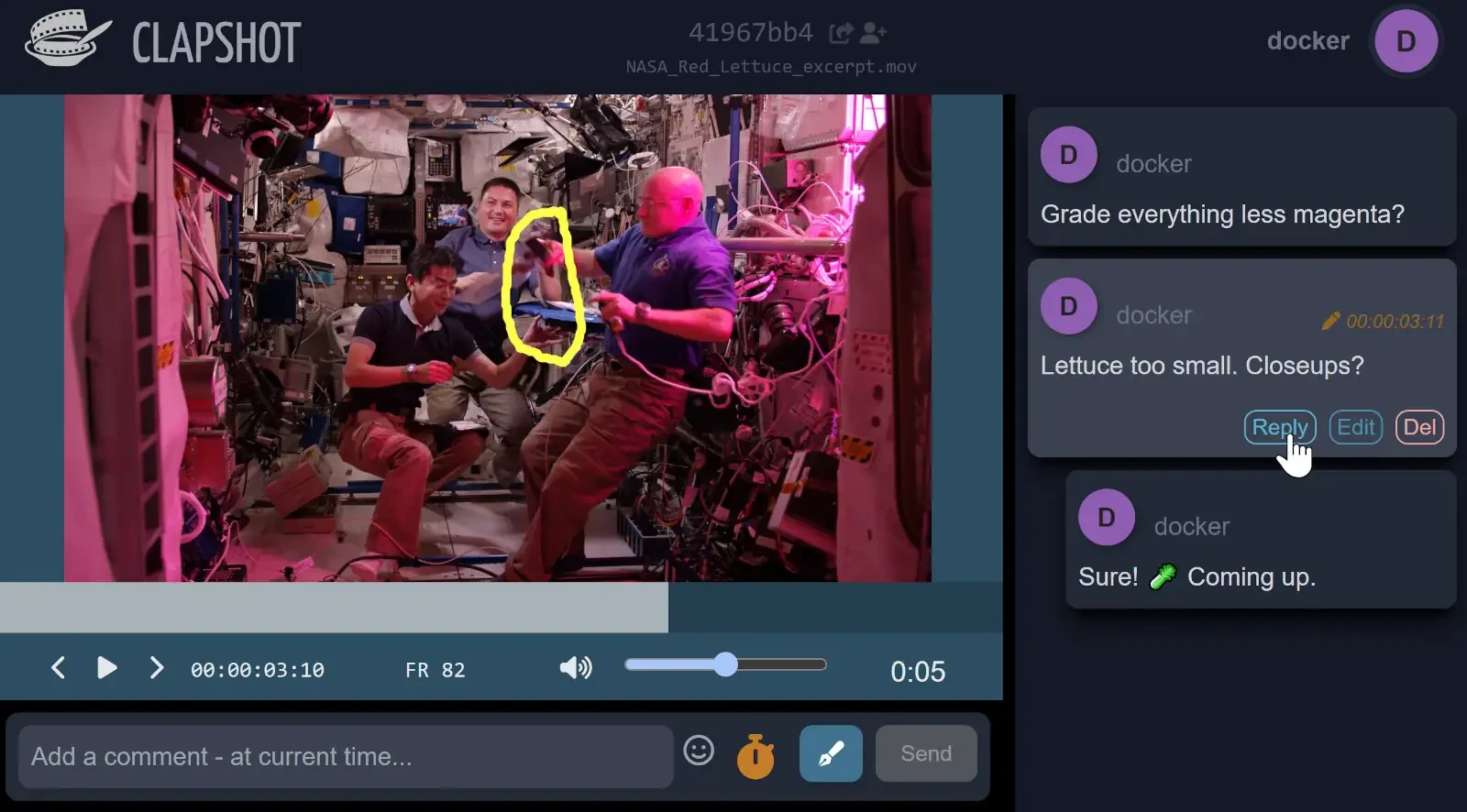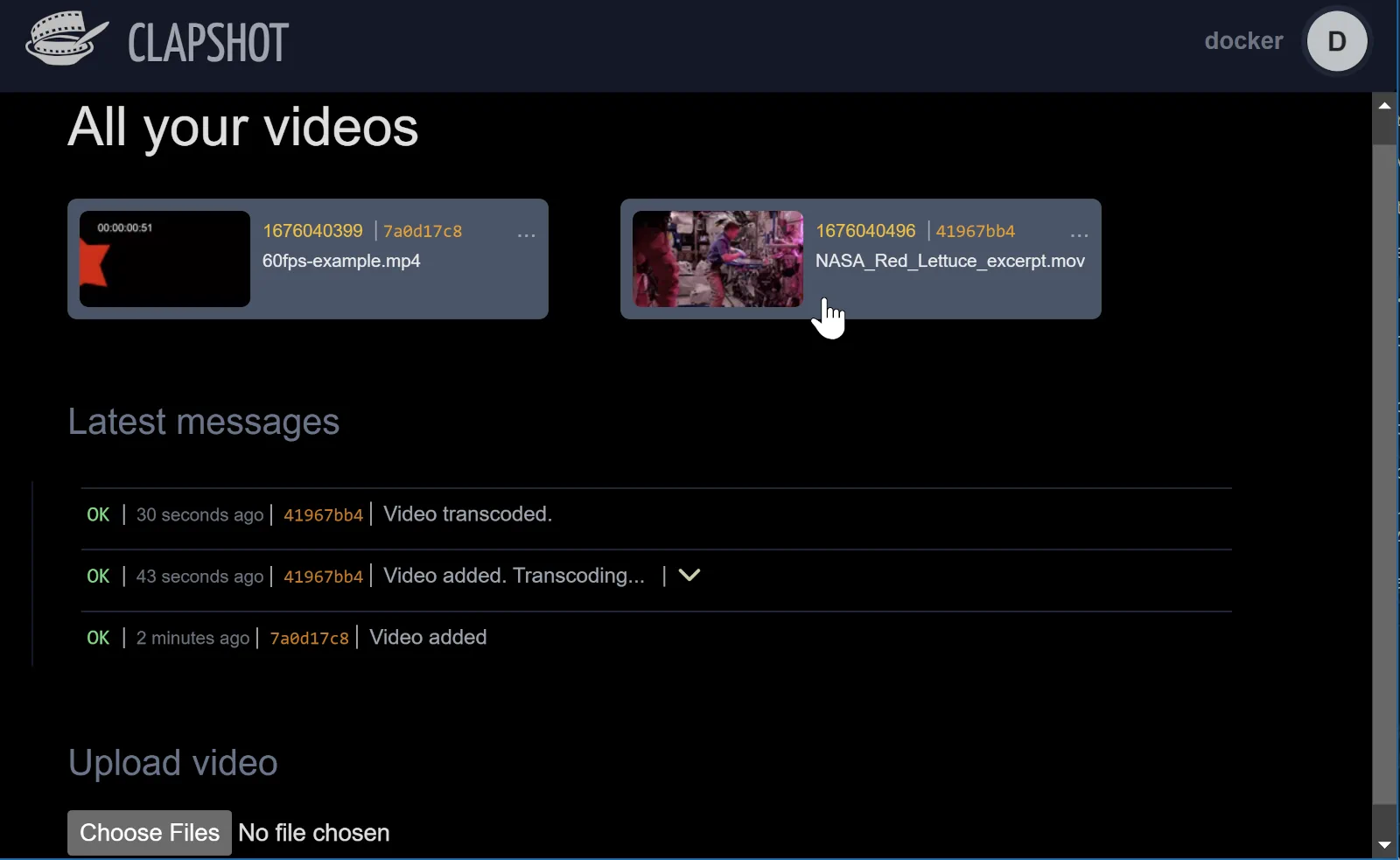Clapshot is a self-hosted, web-based, open source video review/annotation tool. It consists of an API server (written in Rust) and a web UI (written in Svelte).
Users can submit videos by HTTP upload or by copying them to incoming directory (e.g. via Samba).
If bitrate exceeds configured target or codec/container is not recognized as supported (guaranteed to be viewable in a browser),
server transcodes the video with FFMPEG.
After a video is ingested succesfully, users can view the file, add comments, draw annotations and reply to each other's comments. Videos are stored on disk as files, while metadata and comments go to an Sqlite 3.5+ database file.
Clapshot supports collaborative review sessions, where playback controls and drawings are mirrored in real-time to all participants. It's meant to supplement remote video conferences such as Google Meets that don't play video well over screen sharing. Click the "head plus" icon in page header to start it.
To try out Clapshot using Docker, you can either download a demo image from Docker Hub, or clone the repo and run make run-docker to build it manually.
Once the server is running, open your browser at http://127.0.0.1:8080
docker run --rm -it -p 0.0.0.0:8080:80 -v clapshot-demo:/mnt/clapshot-data/data \
elonen/clapshot:latest-demodocker run --rm -it -p 0.0.0.0:8080:80 -v clapshot-demo:/mnt/clapshot-data/data \
elonen/clapshot:latest-demo-htadminThe basic auth version uses https://github.com/soster/htadmin as a simple user management tool (arbitrary choice, just something for a demo).
You can access it at http://127.0.0.1:8080/htadmin/ and create users there (username htadmin, password admin), or just use the default ones: demo/demo, alice/alice123 and admin/admin.
If you want to access the demo from a different host, you'll have to instruct the web client to connect to correct server address. E.g. for 192.168.1.123, add -e CLAPSHOT_URL_BASE='192.168.1.123:8080/ to the docker run command.
Note that each user only sees their own videos in their front page, but can still review and comment on videos uploaded by other users. Users are supposed to share the video URL with each other to collaborate, perhaps by using a chat tool such as Slack, issue tracker or email.
Clapshot server itself contains no authentication code. Instead, it trusts HTTP server (reverse proxy) to take care of that and to pass authenticated user ID and username in request headers. This is exactly what the basic auth / htadmin demo above does, too.
Most modern real-world deployments will likely use some more advanced authentication mechanism, such as OAuth, Kerberos etc, but htadmin is a good starting point.
See /Dockerfile, /test/docker-entry_htadmin.sh and client/debian/additional_files/clapshot+htadmin.nginx.conf for details on how the integration works.
Authorization is also supposed to be handled on web server, at least for now. See for example https://github.com/elonen/ldap_authz_proxy on how to authorize users against Active Directory/LDAP groups using Nginx. I wrote it to complement Nginx spnego authn, which uses Kerberos and thus doesn't really have a concept of groups. If you want to use Kerberos, you may also want to check out https://github.com/elonen/debian-nginx-spnego for .deb packages.
There are currently no demos for any of these more advanced auths (vouch-proxy example for Okta, Google etc. would be especially welcome, if you want to contribute!).
The server is started with command clapshot-server. It stays in the
foreground, and should therefore be started by a process manager such as systemd.
Preferred deployment and upgrade method is to install server and client as Debian
packages. Whereas clapshot-server is a foreground binary that is configured with command line options,
the Debian package contains a systemd service file that demonizes it, and config file /etc/clapshot-server.conf that is translated into the appropriate CLI options automatically.
Server should be put behind a reverse proxy in production, but
can be developed and tested without one. The server .deb package contains
an example Nginx config file (/usr/share/doc/clapshot-server/examples/) that
- reverse proxies the server API (websocket),
- serves out frontend files (.html .js .css),
- serves uploaded video files from
videos/directory, and - contains examples on how to add HTTPS and authentication
While the server uses mostly Websocket, there's a /api/health endpoint that can be used
for monitoring. It returns 200 OK if the server is running.
Some releases require database migrations. If you're upgrading from a previous version, make a backup of your database (clapshot.sqlite) and then either add line migrate = true to /etc/clapshot-server.conf (Debian package) or use --migrate option when running the server manually.
Once the server is started with migrate enabled, it will run database migrations
on startup. After that, you can remove the migrate option and restart the server.
Running the server without migrations enabled will detect that the database is out of date, log an error and exit.
The recommended way to build Clapshot is to use Docker and the provided Makefile:
- Install and start Docker
- At the top level (not "server/" or "client/"), run
make debian-docker
This will build Debian packages and put them in the dist_deb/ directory.
You can also build everything directly on your system, but Docker is cleaner and doesn't require installing extra dependecies. See Makefiles and Dockerfiles for details.
Use make test at top level to run all tests in a Docker container.
During development, running unit tests locally for clapshot-server can be more
convenient. To do so, install Rust + Cargo and issue cd server; make test-local.
Although .deb packages and the bundled config file are the recommended way to run
Clapshot in production (systemctl start clapshot-server.service), it is also possible to
run the server directly from command line and have all logging go to stdout.
This is useful for development and debugging. Call clapshot-server --help to show startup options.
This is my current development setup (in Feb 2023). Adapt to your own needs.
- Windows with WSL2, running Debian Bullseye
- Docker (running inside the WSL2 Debian)
First, open two WSL2 Debian terminals open - one for server dev (Rust), one for client dev (Svelte). Then:
Server:
- install rustup 2021 stable toolchain
cd servercode .to open VS Codemake run-local- builds server, then listens on port 8089, logs to stdout- (optional)
make test-localto run server unit/integration tests without client
Client:
code .to open VS Code (at top level)- Click "reopen in container" button (to avoid installing Node.js and packages locally)
- Open a terminal in VS Code (runs inside the dev container)
cd clientnpm installto install dependenciesnpm run devto start dev HTTP on port 5173
- Open http://localhost:5173/ in browser. Vite will reflect changes to the code
while developing the Svete app, which is very handy. The client will connect Websocket to
ws://localhost:8089/by default, so you can see what the server is doing in the other WSL terminal.
When done, at top level, run one of the following:
make testto build both client and server, and to run all tests in a pristine Docker containermake debian-dockerto test and also build .debs (stored indist_deb/)make run-dockerto automatically build .debs, install them in a Docker container, run server as a systemd service + client as a Nginx site inside it. This is the recommended way to test the whole stackmake build-docker-demoto build a demo image (like the one that can be found in Docker Hub)
Clapshot was started and is currently being maintained / developed for a specific project, so features/releases for generic use may not always be a priority.
That said, feel free to try if it fits your use case and to contribute in development.
For pull requests that introduce significant new code or other materials, please add your name and contribution year to the copyright notices.
Clapshot is licensed under GPL v3 Copyright 2022, 2023 by Jarno Elonen


